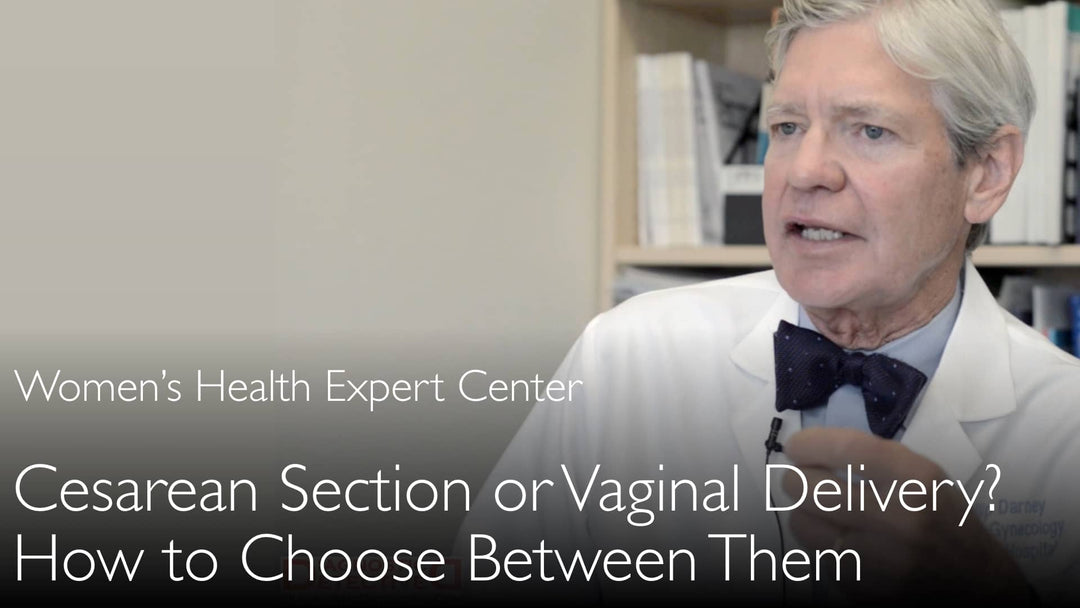Cesarean Section vs. Natural Birth: How to Decide What’s Best for Mother and Baby
Leading obstetrics and gynecology expert Dr. Philip Darney, MD, in conversation with Dr. Anton Titov, MD, discusses the critical decision between cesarean section (C-section) and natural vaginal birth. He explains why, in most cases, vaginal delivery is the safest choice for both mother and baby — and why C-sections should only be performed when medically necessary. The discussion covers the risks of unnecessary surgical delivery, the impact of C-section on future pregnancies, and why low cesarean rates are linked to better maternal and newborn outcomes. Examples from San Francisco General Hospital illustrate how prioritizing natural birth can make a facility one of the safest in the country for deliveries.
Jump To Section
- When to Consider Cesarean Section
- Why Vaginal Delivery Is Safest for Mother and Baby
- Risks of Unnecessary Cesarean Sections
- Impact of C-Section on Future Pregnancies
- Hospital Example: How Low C-Section Rates Improve Safety
- Full Transcript
When to Consider Cesarean Section
According to Dr. Philip Darney, MD, a cesarean section should only be performed when medically indicated. Conditions such as breech presentation or placenta previa may make vaginal delivery unsafe, and in these cases, a C-section is the right choice. However, scheduling a C-section without a medical reason exposes both mother and baby to unnecessary risks. Induction of labor should also be reserved for situations where it is medically necessary.
Why Vaginal Delivery Is Safest for Mother and Baby
Vaginal delivery, when there are no complications, is the safest method for both the mother and the baby. Natural birth supports faster maternal recovery, lower complication rates, and better health outcomes for future pregnancies. Dr. Darney emphasizes that full-term pregnancy, at around 40 weeks, should be allowed to progress naturally unless intervention is required for medical reasons.
Risks of Unnecessary Cesarean Sections
The global rise in cesarean deliveries is concerning. C-section is a major surgical procedure that can lead to complications such as infections, bleeding, and blood clots. For babies, it can result in respiratory issues and other complications. These risks increase when the surgery is not medically indicated and is performed too early.
Impact of C-Section on Future Pregnancies
A first C-section often leads to repeat cesareans in future pregnancies. This increases the risk of complications such as placenta accreta, uterine rupture, and other serious conditions. Choosing vaginal delivery when possible preserves more options for future childbirth and reduces the likelihood of these risks.
Hospital Example: How Low C-Section Rates Improve Safety
San Francisco General Hospital, where Dr. Darney practices, has been recognized as the safest place in California for mothers and babies. One major reason is its low cesarean section rate. By avoiding unnecessary surgical deliveries and prioritizing safe, natural births, the hospital has achieved better outcomes for both mothers and newborns.
Full Transcript
Dr. Anton Titov, MD: Cesarean section or natural birth. How to decide? Is cesarean section better than natural birth for mother and for baby? Leading expert in obstetrics and gynecology shares his view. Safety of C-section vs. vaginal delivery for mother and baby.
Dr. Anton Titov, MD: How to decide to deliver a baby by cesarean section or natural birth? What is safer? C-section or natural delivery? How to compare cesarean section versus natural birth? Professor of obstetrics from San Francisco answers questions about cesarean section and vaginal birth.
Induction of labor and cesarean section have to be done only when medical indications exist. Vaginal delivery is the safest method for baby and mother. Natural birth is also better for future pregnancies. First cesarean section often requires C-sections in subsequent pregnancies.
Medical second opinion confirms that breech presentation and placenta previa diagnosis is correct and complete. Medical second opinion also confirms that cesarean section is required. Medical second opinion helps to choose the best treatment for placenta previa and breech presentation. Get medical second opinion on placenta previa and be confident that your treatment is the best.
Dr. Anton Titov, MD: Cesarean section or vaginal delivery for a normal pregnancy. Is it a question of a woman’s choice if there are no medical indications for C-section? How to decide whether vaginal birth or cesarean section is better? How to deliver a baby after uncomplicated pregnancy?
Dr. Philip Darney, MD: Cesarean section delivery should only be done when it is medically necessary. Induction of labor for a vaginal delivery should be done only when it is medically necessary. Cesarean delivery and induction of labor in vaginal delivery can be done too early, and this is dangerous. The baby should be delivered when it’s ready to be delivered. Pregnancy becomes full term at forty weeks. Cesarean delivery without medical indications is harmful for both the mother and for the baby. Rising rates of cesarean section delivery all around the world are of concern. Higher rates of cesarean delivery increase the risk to both mother and baby in subsequent pregnancies. Cesarean delivery itself can result in complications to both mother and child. It is difficult to anticipate some complications of C-section. So vaginal delivery whenever possible is the best course of action.
Dr. Anton Titov, MD: This is very important because frequently a scheduled cesarean section delivery is convenient for the hospital and for doctors. Maybe this convenience of C-section delivery accounts for the growth in cesarean sections around the world. But natural vaginal birth is the safest. It is the best for both mother and child.
Dr. Philip Darney, MD: Yes. I will give an example. We are now in San Francisco General Hospital. There was an article in the New York Times about San Francisco General Hospital. It is the safest place for mother and baby in California. Why is this hospital the safest for baby delivery? It was mostly because we have a very low rate of cesarean section deliveries.
Dr. Anton Titov, MD: Cesarean section or natural birth. How to decide? What is safer for mother and best for child? The best method to deliver a child is a natural vaginal delivery.







